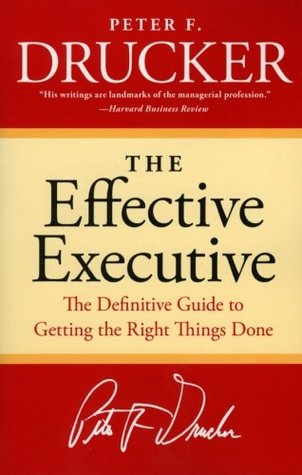
This is a crisp booklet by the famous management consultant Peter Drucker. It focuses on a few time tested general practices and hammers them home nicely rather than getting lost in the weeds. It draws upon decades of the author’s practice and probably due to that, I was delighted to find subtle gems of practical insight tucked away in otherwise routine paras where I was least expecting them.
The book starts off by saying that “effectiveness” can be learned as a habit (a collection of practices) and need not be seen as a personality trait. Well, there would be no need to write this book otherwise, wouldn’t it? 😉 The book was probably written at a time when knowledge/intellectual work had only just become the predominant way to a middle class lifestyle and hence would have been pioneering. There’s a quaint bit about how American executives are known to rise from the ranks and rarely have advanced management degrees!
The author breaks down the Effectiveness habit into five parts: making decisions, managing time, figuring out how to contribute, building on people’s strengths and sorting out priorities.
As the book delves into each of these, it strikes a good balance between abstract philosophy and concrete examples. The examples are drawn from the US’s heydays as an industrial and intellectual powerhouse — General Motors, Bell Labs, WW2 commanders, Roosevelt, Robert McNamara etc.
Decision making is a large part of an executive’s responsibilities and there are two substantial chapters about it, albeit towards the end. There are four steps outlined for how to arrive at effective decisions. But I sensed an undercurrent of reactivity in this section. The examples given are “problems” an executive is trying to solve rather than the framework of “How can I Contribute”, which was brought up earlier. It doesn’t help that the author chooses the one time heads of Bell Technologies and General Motors as exemplars, making the situations hard to relate to. The subsequent chapter on “effective decisions” has some contrarian insights. Decisions don’t flow from a consensus on facts. Instead, the executive begins by soliciting opinions and stoking disagreement. These are basically necessary to get a sense of what is at stake, and what the decision is really all about. Without opinions about the nature of the decision needed, you don’t even know what are the relevant facts that need to be brought into the picture! These opinions are then tested against reality, and the decision making process continues.
The chapter on focusing on your (and your subordinate’s) strengths is the most thought provoking. The author marshals examples from the Civil War to the World Wars and some corporate cases to prove that organizations should maximize a person’s strengths and not unduly emphasize or penalize their weaknesses. People with great abilities may come with great weaknesses (not sure how this will fly in today’s politically correct world!), or just simply the time commitment needed to gain mastery may result in not having a well rounded set of skills. So the organization’s goal should be to extract the unique value out of the person while managing their shortcomings.
The author doesn’t go into much detail on how to figure out your strengths (probably enough other books exist for that). But for a taste of what he’s considering: are you a people-person or prefer to be by yourself, are you a listener or a reader, do you like pithy summaries or long explanations, morning person or not … etc. At one point he remarks that everyone has figured out these things by the time they’re an adult — something I thought was too rooted in a fixed mindset.
Figuring out what to contribute is an interesting chapter. This is a must read for entry level managers who may otherwise remain glorified foot soldiers and inter-departmental messengers. The author exhorts executives to focus proactively on what will keep stakeholders/customers happy. A beneficial side effect of this is that you become outward focused (results and customer satisfaction) rather than inward focussed (efforts, processes, efficiencies). I liked this way of framing the issue. Although it’s seldom easy for people low in the corporate hierarchy to get their own ideas implemented, it doesn’t hurt to keep an eye out for opportunities.
Time management gets a lot of treatment upfront. The key principle is to block out large chunks of uninterrupted time for quality work on things of the highest priority. If an executive can’t manage this, he will necessarily miss accomplishing the most important things and his effectiveness drops down. Since the nature of the role means there’s always an enormous demand on an executive’s time, conscious and periodic review of one’s time expenditure is key. Or else you’ll be just constantly reacting to events around you. He does get into a few techniques to address this, but as with many things in this book, he assumes the reader is intelligent enough to figure out what works for them.
The book ends with a flourish, with the conclusive chapter trying to situate executives within the entire post War society of the West. Since more and more people are getting involved in knowledge work, the author claims that executive effectiveness can determine a good part of the success of modern societies. While that is a bit too dramatic, the author still manages to tie together all the earlier strands beautifully, and offers some poignant glimpses of the inner life of a modern knowledge worker. This chapter alone was enough to convince me that Drucker is both an expert and a great exponent of management ideas.